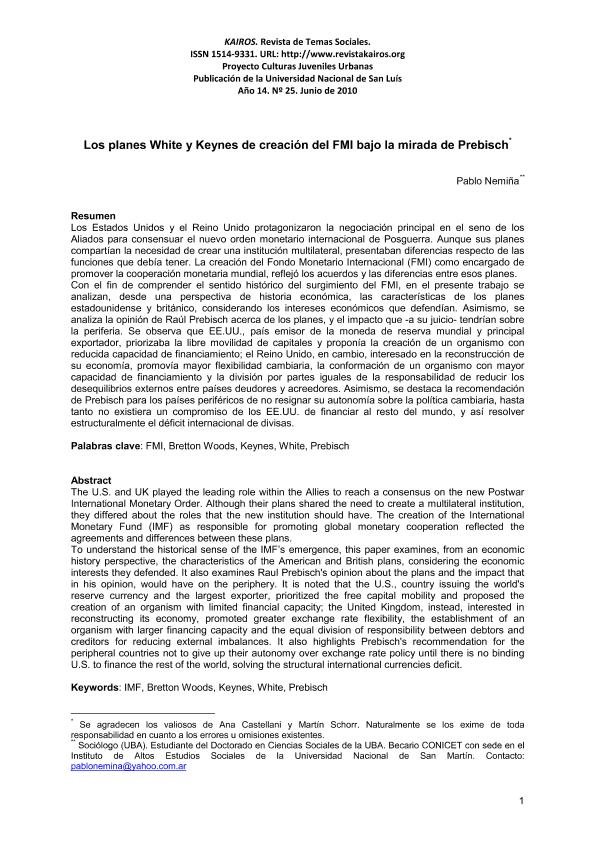Artículo
Los Estados Unidos y el Reino Unido protagonizaron la negociación principal en el seno de los Aliados para consensuar el nuevo orden monetario internacional de Posguerra. Aunque sus planes compartían la necesidad de crear una institución multilateral, presentaban diferencias respecto de las funciones que debía tener. La creación del Fondo Monetario Internacional (FMI) como encargado de promover la cooperación monetaria mundial, reflejó los acuerdos y las diferencias entre esos planes. Con el fin de comprender el sentido histórico del surgimiento del FMI, en el presente trabajo se analizan, desde una perspectiva de historia económica, las características de los planes estadounidense y británico, considerando los intereses económicos que defendían. Asimismo, se analiza la opinión de Raúl Prebisch acerca de los planes, y el impacto que -a su juicio- tendrían sobre la periferia. Se observa que EE.UU., país emisor de la moneda de reserva mundial y principal exportador, priorizaba la libre movilidad de capitales y proponía la creación de un organismo con reducida capacidad de financiamiento; el Reino Unido, en cambio, interesado en la reconstrucción de su economía, promovía mayor flexibilidad cambiaria, la conformación de un organismo con mayor capacidad de financiamiento y la división por partes iguales de la responsabilidad de reducir los desequilibrios externos entre países deudores y acreedores. Asimismo, se destaca la recomendación de Prebisch para los países periféricos de no resignar su autonomía sobre la política cambiaria, hasta tanto no existiera un compromiso de los EE.UU. de financiar al resto del mundo, y así resolver estructuralmente el déficit internacional de divisas. The U.S. and UK played the leading role within the Allies to reach a consensus on the new Postwar International Monetary Order. Although their plans shared the need to create a multilateral institution, they differed about the roles that the new institution should have. The creation of the International Monetary Fund (IMF) as responsible for promoting global monetary cooperation reflected the agreements and differences between these plans. To understand the historical sense of the IMF’s emergence, this paper examines, from an economic history perspective, the characteristics of the American and British plans, considering the economic interests they defended. It also examines Raul Prebisch’s opinion about the plans and the impact that in his opinion, would have on the periphery. It is noted that the U.S., country issuing the world’s reserve currency and the largest exporter, prioritized the free capital mobility and proposed the creation of an organism with limited financial capacity; the United Kingdom, instead, interested in reconstructing its economy, promoted greater exchange rate flexibility, the establishment of an organism with larger financing capacity and the equal division of responsibility between debtors and creditors for reducing external imbalances. It also highlights Prebisch’s recommendation for the peripheral countries not to give up their autonomy over exchange rate policy until there is no binding U.S. to finance the rest of the world, solving the structural international currencies deficit.
Los planes White y Keynes de creación del FMI bajo la mirada de Prebisch
Fecha de publicación:
06/2010
Editorial:
Universidad Nacional de San Luis. Proyecto "Culturas Juveniles"
Revista:
Kairos
ISSN:
1514-9331
Idioma:
Español
Tipo de recurso:
Artículo publicado
Clasificación temática:
Resumen
Palabras clave:
FMI
,
Bretton Woods
,
Keynes
,
White
Archivos asociados
Licencia
Identificadores
Colecciones
Articulos(SEDE CENTRAL)
Articulos de SEDE CENTRAL
Articulos de SEDE CENTRAL
Citación
Nemiña, Pablo Luis; Los planes White y Keynes de creación del FMI bajo la mirada de Prebisch; Universidad Nacional de San Luis. Proyecto "Culturas Juveniles"; Kairos; 14; 25; 6-2010; 1-19
Compartir




